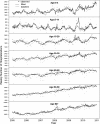Hospitalization risk of the 2009 H1N1 pandemic cases in Hong Kong
- PMID: 24428855
- PMCID: PMC3898487
- DOI: 10.1186/1471-2334-14-32
Hospitalization risk of the 2009 H1N1 pandemic cases in Hong Kong
Abstract
Background: Reliable assessment for the severity of the 2009 H1N1 pandemic influenza is critical for evaluation of vaccination strategies for future pandemics. This study aims to estimate the age-specific hospitalization risks of the 2009 pandemic cases during the first wave in Hong Kong, by combining the findings from the serology and disease burden studies.
Methods: Excess hospitalization rates associated with the pandemic H1N1 were estimated from Poisson regression models fitted to weekly total numbers of non-accidental hospitalization from 2005 to 2010. Age-specific infection-hospitalization risks were calculated as excess hospitalization rates divided by the attack rates in the corresponding age group, which were estimated from serology studies previously conducted in Hong Kong.
Results: Excess hospitalization rate associated with pandemic H1N1 was highest in the 0-4 age group (881.3 per 100,000 population), followed by the 5-14, 60+, 15-29, 50-59, 30-39 and 40-49 age groups. The hospitalization risk of the infected cases (i.e. infection-hospitalization risk) was found highest in the 60+ age group and lowest in the 15-29 age group, with the estimates of 17.5% and 0.7%, respectively.
Conclusions: People aged 60 or over had a relatively high infection-hospitalization risk during the first wave of the 2009 H1N1 pandemic, despite of a low attack rate in this age group. The findings support the policy of listing older people as the priority group for pandemic vaccination.
Figures
Similar articles
-
Hospitalisation associated with the 2009 H1N1 pandemic and seasonal influenza in Hong Kong, 2005 to 2010.Euro Surveill. 2012 Nov 8;17(45):20309. Euro Surveill. 2012. PMID: 23153475
-
Epidemiological characteristics of 2009 (H1N1) pandemic influenza based on paired sera from a longitudinal community cohort study.PLoS Med. 2011 Jun;8(6):e1000442. doi: 10.1371/journal.pmed.1000442. Epub 2011 Jun 21. PLoS Med. 2011. PMID: 21713000 Free PMC article.
-
Age and Sex Differences in Rates of Influenza-Associated Hospitalizations in Hong Kong.Am J Epidemiol. 2015 Aug 15;182(4):335-44. doi: 10.1093/aje/kwv068. Epub 2015 Jul 27. Am J Epidemiol. 2015. PMID: 26219977
-
Virologically confirmed population-based burden of hospitalization caused by influenza A and B among children in Hong Kong.Clin Infect Dis. 2009 Oct 1;49(7):1016-21. doi: 10.1086/605570. Clin Infect Dis. 2009. PMID: 19722912
-
The epidemiological and public health research response to 2009 pandemic influenza A(H1N1): experiences from Hong Kong.Influenza Other Respir Viruses. 2013 May;7(3):367-82. doi: 10.1111/j.1750-2659.2012.00420.x. Epub 2012 Aug 9. Influenza Other Respir Viruses. 2013. PMID: 22883352 Free PMC article. Review.
Cited by
-
A joint analysis of influenza-associated hospitalizations and mortality in Hong Kong, 1998-2013.Sci Rep. 2017 Apr 20;7(1):929. doi: 10.1038/s41598-017-01021-x. Sci Rep. 2017. PMID: 28428558 Free PMC article.
-
Compassionate drug (mis)use during pandemics: lessons for COVID-19 from 2009.BMC Med. 2020 Aug 21;18(1):265. doi: 10.1186/s12916-020-01732-5. BMC Med. 2020. PMID: 32825816 Free PMC article.
References
-
- Riley S, Kwok KO, Wu KM, Ning DY, Cowling BJ, Wu JT, Ho LM, Tsang T, Lo SV, Chu DK, Ma ES, Peiris JS. Epidemiological characteristics of 2009 (H1N1) pandemic influenza based on paired sera from a longitudinal community cohort study. PLoS Med. 2011;14(6):e1000442. doi: 10.1371/journal.pmed.1000442. - DOI - PMC - PubMed
-
- Wu JT, Ma ES, Lee CK, Chu DK, Ho PL, Shen AL, Ho A, Hung IF, Riley S, Ho LM, Lin CK, Tsang T, Lo SV, Lau YL, Leung GM, Cowling BJ, Malik Peiris JS. The infection attack rate and severity of 2009 pandemic H1N1 influenza in Hong Kong. Clin Infect Dis. 2010;14(10):1184–1191. doi: 10.1086/656740. - DOI - PMC - PubMed
Publication types
MeSH terms
LinkOut - more resources
Full Text Sources
Other Literature Sources
Medical


